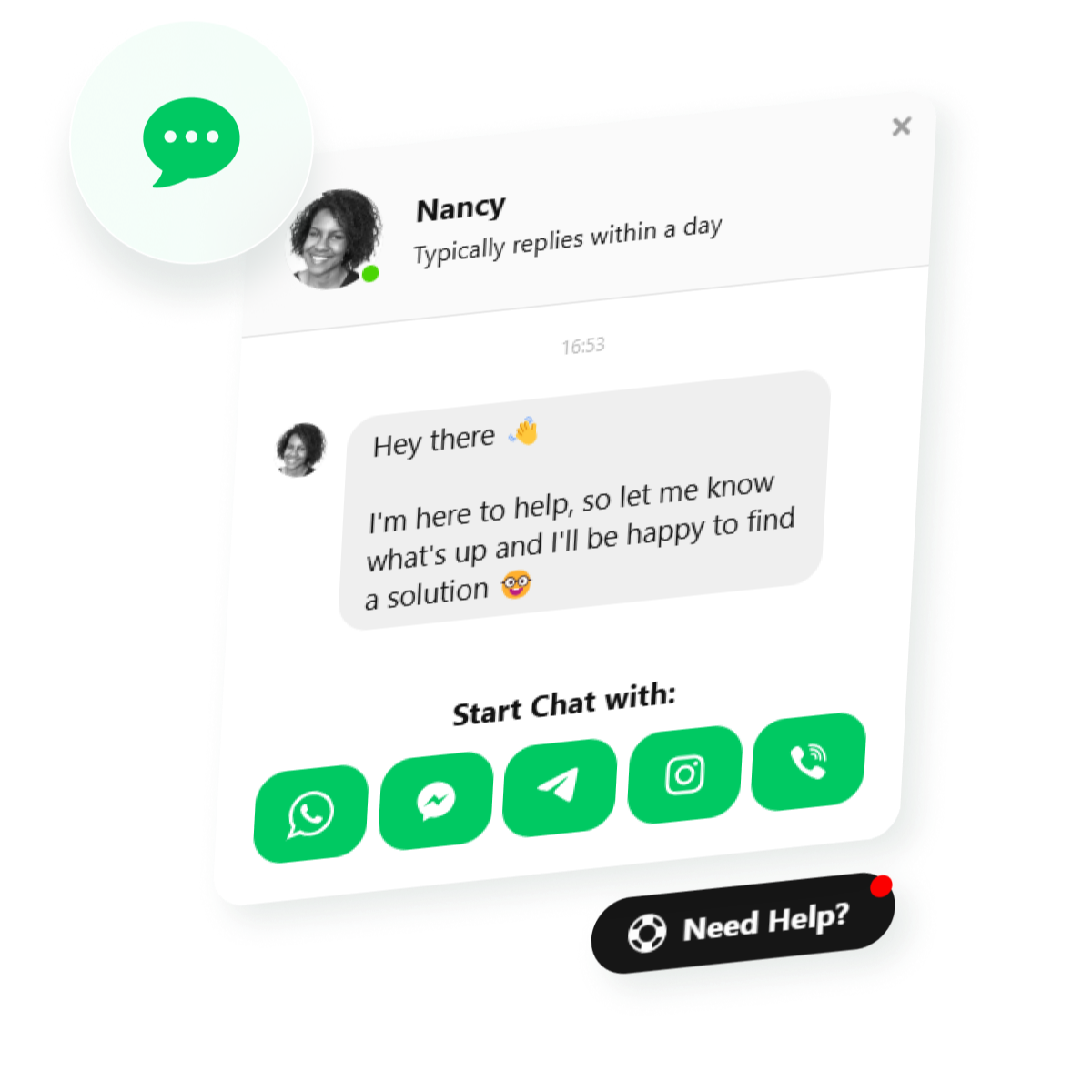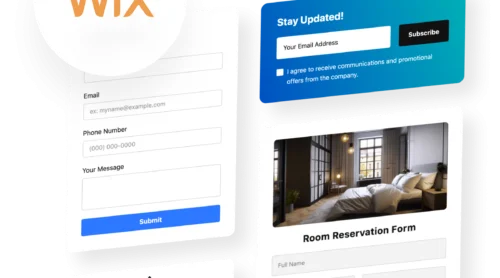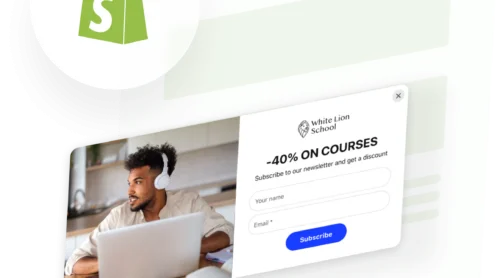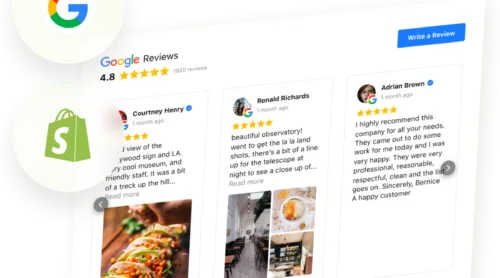Live chat transforms how visitors interact with your website. Rather than forcing users to wait for email responses or navigate phone queues, real-time chat creates direct, immediate connections that address questions and concerns the moment they arise. However, simply deploying a chat widget isn’t enough—strategic design, intentional placement, and thoughtful customization are what truly convert casual browsers into engaged customers.
- Visitors prefer live chat for real-time answers: quick response times and written conversation history reduce friction compared to phone or email.
- Chat removes common pain points: no long hold times, no guesswork, and no need to memorize canned responses.
- Support teams gain efficiency: agents can handle multiple conversations simultaneously, improving productivity without adding headcount.
- Customers feel valued and heard: immediate responses signal that their time matters, increasing trust and loyalty.
The All-in-One Chat widget consolidates multiple messaging platforms—WhatsApp, Facebook Messenger, Telegram, Instagram, Viber, and others—into a single, unified interface integrated directly into your website. This guide provides practical, step-by-step strategies for implementation, design customization, and industry-specific optimization to maximize engagement and drive measurable business results.
Create Your Live Chat in Four Steps
If you want to get a live chat running fast, this shortcut is for you. With Elfsight’s All-in-One Chat widget, you can build and launch a chat for your website in just a few easy steps:
- Open Elfsight’s editor and pick a chat template.
- Customize your Live Chat widget.
- Click ‘Add to website for free’ and copy the generated code.
- Paste the code into your website’s backend.
🚀 Give it a try now and create your live chat in the free editor!
Tailor Your Contact Form to a Use Case
Every business has different needs when it comes to live chat features, and the right structure can make all the difference. The way you set up your chat depends on who you’re helping, what you want to achieve, and how your audience likes to communicate. Below, you’ll find five practical use cases—each with a tailored approach to fit real-world goals.
📞 Support – Customer Help Desk
Applies to: online stores, service providers, SaaS companies, hospitality businesses.
Goal: Provide instant, friendly help with orders, accounts, or general questions
User motivation: High — people want quick answers when they’re stuck
Template match: Support Chat Widget Example
When users are confused or facing problems, a well-placed support chat makes it easy for them to get help right away. The template keeps things simple and approachable, with a clean chat window and visible contact options so visitors don’t need to search for help. Canned responses and agent availability cues mean faster replies, and users feel heard instead of lost in a queue.
Recommended Structure
- Visible chat launcher with “Need help?” prompt
- Agent name and avatar for personal touch
- Quick-reply buttons for common issues
- Option to request a transcript for follow-up
💰 Sale – Product Consultation
Applies to: ecommerce, retail, subscription services.
Goal: Guide visitors toward the right product and increase conversion
User motivation: Moderate — users want advice before they buy
Template match: Sales Chat Widget Example
When someone’s weighing a purchase, direct chat support can tip the scales. This template offers quick access to product experts, with prompts for featured items or discounts. Visitors feel confident making decisions, especially when they can get recommendations or clarification on specs and pricing right away.
Recommended Structure
- Welcome message highlighting current deals
- Product selection buttons or quick links
- Space for short, specific questions
- CTA: “Get your exclusive offer now”
📅 Booking – Reservation Assistant
Applies to: hotels, restaurants, clinics, event organizers.
Goal: Make booking fast and hassle-free
User motivation: High — users want to secure a time or spot with minimal effort
Template match: Booking Chat Widget Example
Booking can feel like a chore, but this widget streamlines things. It offers an uncluttered chat window with clear prompts for dates, times, and preferences, plus instant confirmation for peace of mind. Users can ask about availability, special requests, or even get recommendations for their visit—all without leaving the page.
Recommended Structure
- Date and time selector within chat
- Pre-filled questions (party size, special requests)
- Instant booking confirmation message
- Reminder and cancellation options
💬 Feedback – Customer Insights
Applies to: service businesses, online stores, training platforms.
Goal: Collect honest feedback to shape future improvements
User motivation: Low to moderate — users share thoughts if it’s easy
Template match: Feedback Chat Widget Example
Feedback helps you grow, but people dislike long surveys. This widget template makes sharing opinions quick and painless. It uses short, friendly prompts and lets users pick from emoji ratings or leave a brief comment. The simple structure encourages participation, especially right after a purchase or service experience.
Recommended Structure
- Emoji or star rating for instant feedback
- One quick multiple-choice question
- Expandable comment box
- Thank-you message with a positive feel
👨💼 Onboarding & Consultation – Guided Setup
Applies to: SaaS onboarding, agencies, professional services, training providers.
Goal: Help new users start strong and answer complex questions
User motivation: High — users are eager but need direction
Template match: Consultation Chat Widget Example
Getting started with a new product or service can be confusing. This template guides users through onboarding or consultation step by step, with tailored prompts and expert advice. Users can ask for help, get resources, or book a one-on-one call—all from the chat window. The experience feels supportive and reduces drop-off during setup.
Recommended Structure
- Welcome message with step-by-step instructions
- Quick access to guides or video tutorials
- Option to schedule a live call or chat with an expert
- Progress tracker or checklist
Preview more interactive Live Chat Examples to find the perfect one for your business needs.
Common Live Chat Widget Hurdles & Tested Solutions
Even with the best intentions, live chat widgets can frustrate both teams and visitors if they aren’t set up with care. Here’s a look at the issues that come up most often—and how Elfsight’s widget helps you nip them in the bud.
| Widget Issue | Why It Happens | How Elfsight Helps |
|---|---|---|
| Widget not showing up on the website | Code is placed in the wrong part of the HTML, or the widget is not enabled | Clear install guides walk you through pasting the code in the correct spot, and simple toggles control widget activation |
| Chat pops up at the wrong time (too early or too often) | Widget triggers are set too aggressively, interrupting visitors | Behavior-based triggers let you show the chat only when users are likely to want help (like after they’ve lingered or scrolled) |
| Missed chats when team is offline | No clear indication of agent availability, leading to unanswered messages | Custom offline messages and auto-replies set expectations and offer contact forms when nobody is available |
| Brand mismatches or generic appearance | Widget isn’t customized for your brand, which can feel out of place | Easy design options let you match colors, text, and avatars to your branding—no coding needed |
| Confusing or cluttered chat interface | Too many fields, unclear prompts, or a busy layout | Streamlined customization of welcome messages, fields, and prompts keeps things simple for users |
| Settings changes don’t appear immediately | Caching or session issues cause updated settings not to show | Instant updates ensure changes take effect right away, so you see what users see |
Most live chat issues come down to structure and clarity. By setting up your widget thoughtfully, you can remove nearly every barrier. Next, let’s walk through how to customize your Elfsight widget step by step.
Crafting Solutions: How to Make Live Chat from Scratch
Once you know the types of chat interactions your audience expects, you can transform a standard widget into a seamless part of your website. This section gives you every step, from choosing channels and styling options to embedding and optimizing the chat experience.
1. Choose a Chat Template
Open the All-in-One Chat editor and select a pre-built template that aligns with your business goals. Each template is optimized for specific interaction patterns and comes with recommended channel configurations.
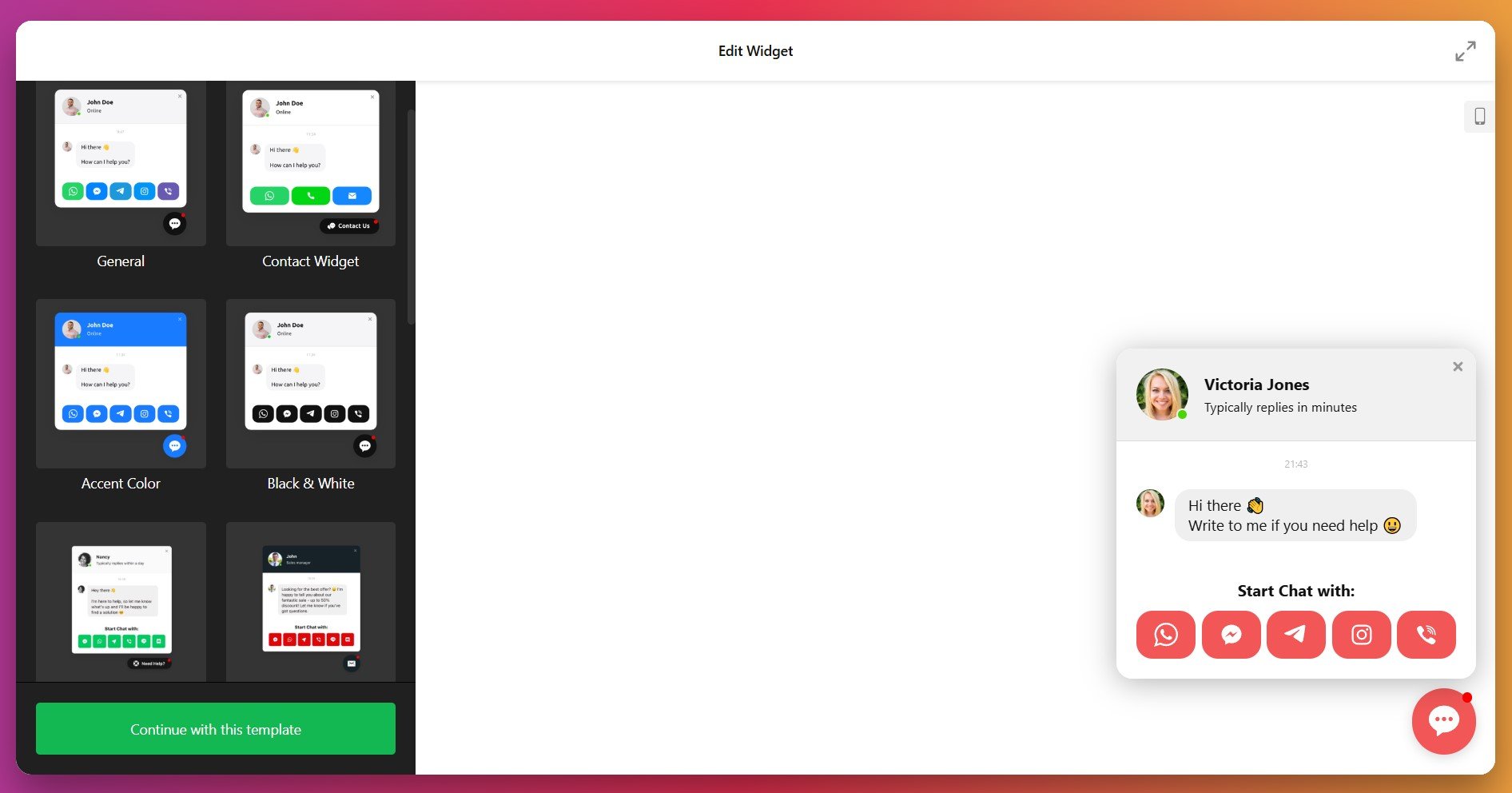
E.g. Booking Chat for service businesses, Onboarding Chat – great for SaaS and educational platforms, etc. Click “Continue with this template” to proceed to customization.
2. Add Your Messaging Channels
Navigate to the ‘Contacts’ tab and click “Add Contact” to connect your preferred messaging platforms. The widget supports most popular messengers:
- WhatsApp (include full phone number with country code, e.g., +12345678900)
- Facebook Messenger (requires your Facebook Page username)
- Telegram (use your @username or bot link)
- Instagram (Direct Messages username required)
- Viber (phone number)
- Email (your support email address)
- SMS (phone number)
As well as utility buttons like Call, Get Directions, and Custom Links.
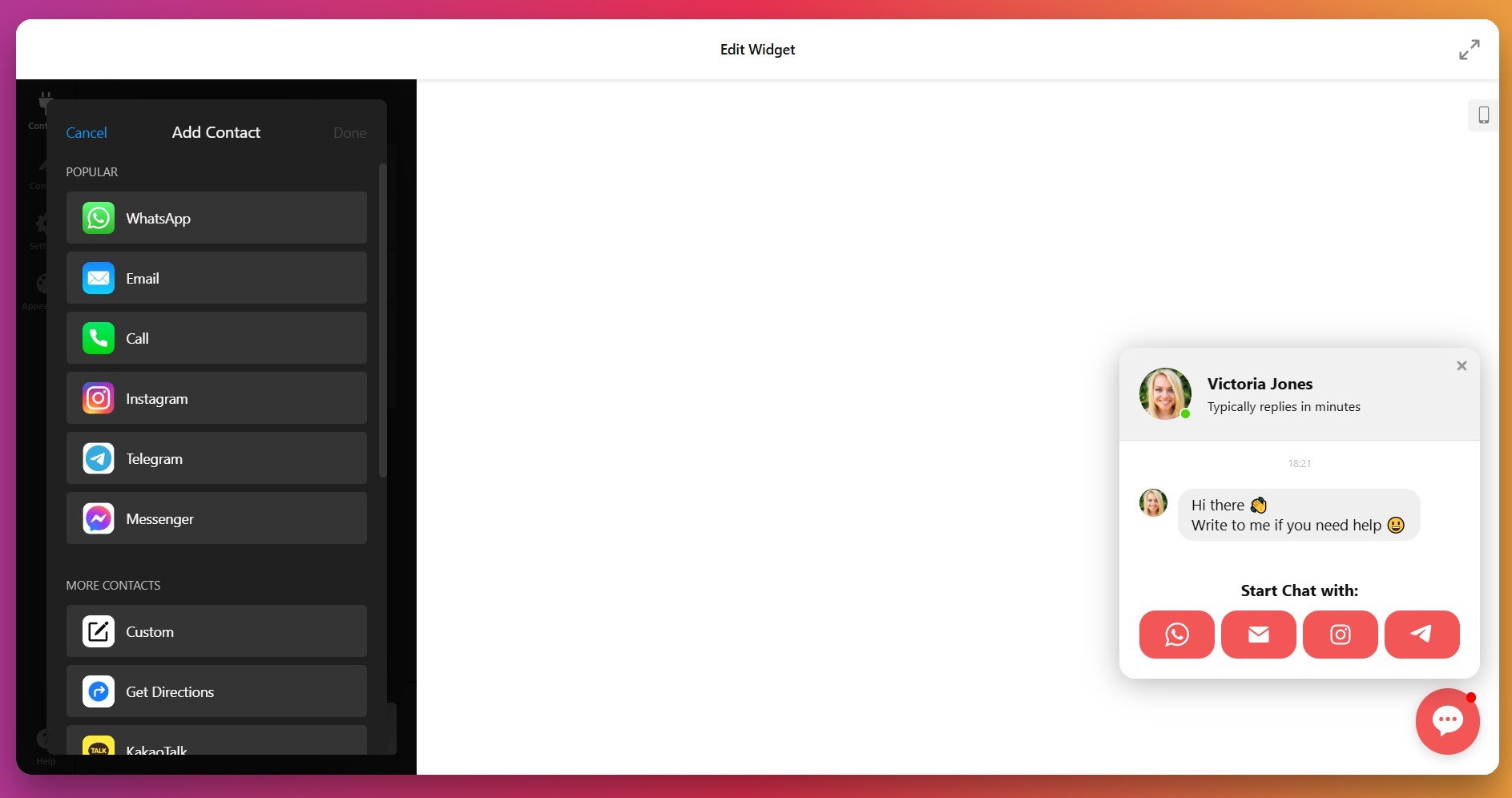
You can enable as many channels as needed to meet customers where they already communicate.
3. Personalize Agent Information and Messages
Open the “Content” tab to configure your chat agent’s identity. Add your Agent Name (use real team member names for authenticity), upload a Profile Photo (human faces increase trust and response rates), and set your Availability Status—choose between “Online,” display estimated reply time (e.g., “Replies in ~2 hours”), or create a custom status message.
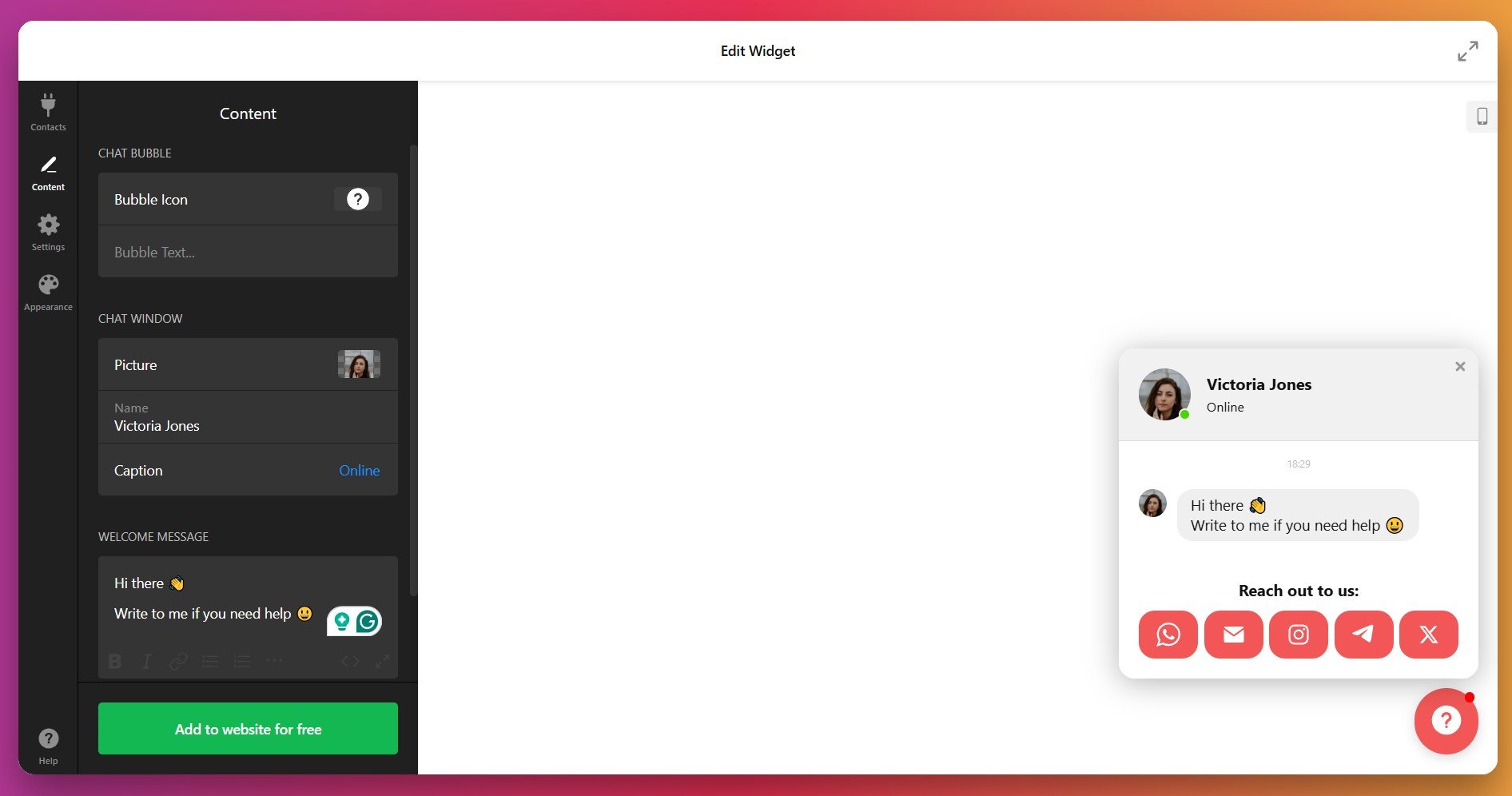
Craft a concise, contextual Welcome Message that appears when visitors open the chat window—effective greetings are under 10 words and address specific page context, such as “Need help choosing the right plan?” on pricing pages or “Questions about shipping?” on product pages.
4. Customize the Chat Bubble
Still in the ‘Content’ tab, scroll to the Chat Bubble section. Select an icon from Elfsight’s library (options include chat bubbles, headsets, messaging icons, and platform-specific logos) or upload your own company logo for maximum brand consistency.
Add optional Bubble Text that appears next to the icon (e.g., “Chat with us!” or “Need help?”) to encourage interaction.
5. Configure Display Triggers and Behavior
Navigate to the ‘Settings’ tab and open Chat Display Settings. Define when and where your widget appears using four powerful targeting options:
- Pages: Choose “All Pages” for site-wide display, “Specific Pages” to show chat only on designated URLs (perfect for high-intent pages like pricing, checkout, or contact), or “Excluded Pages” to hide chat from certain areas. You can type “homepage” to specifically target or exclude your homepage.
- Devices: Select desktop, mobile, or both to control which devices display the chat widget. Mobile-first businesses should ensure mobile optimization is perfect.
- Visitors: Target “All Visitors,” “New Visitors” (first-time site guests), or “Returning Visitors” (users who’ve been to your website before) to personalize the chat experience based on familiarity.
- Date & Time: Set a schedule for when chat should be visible—ideal for businesses with specific operating hours or time-zone-based support teams.
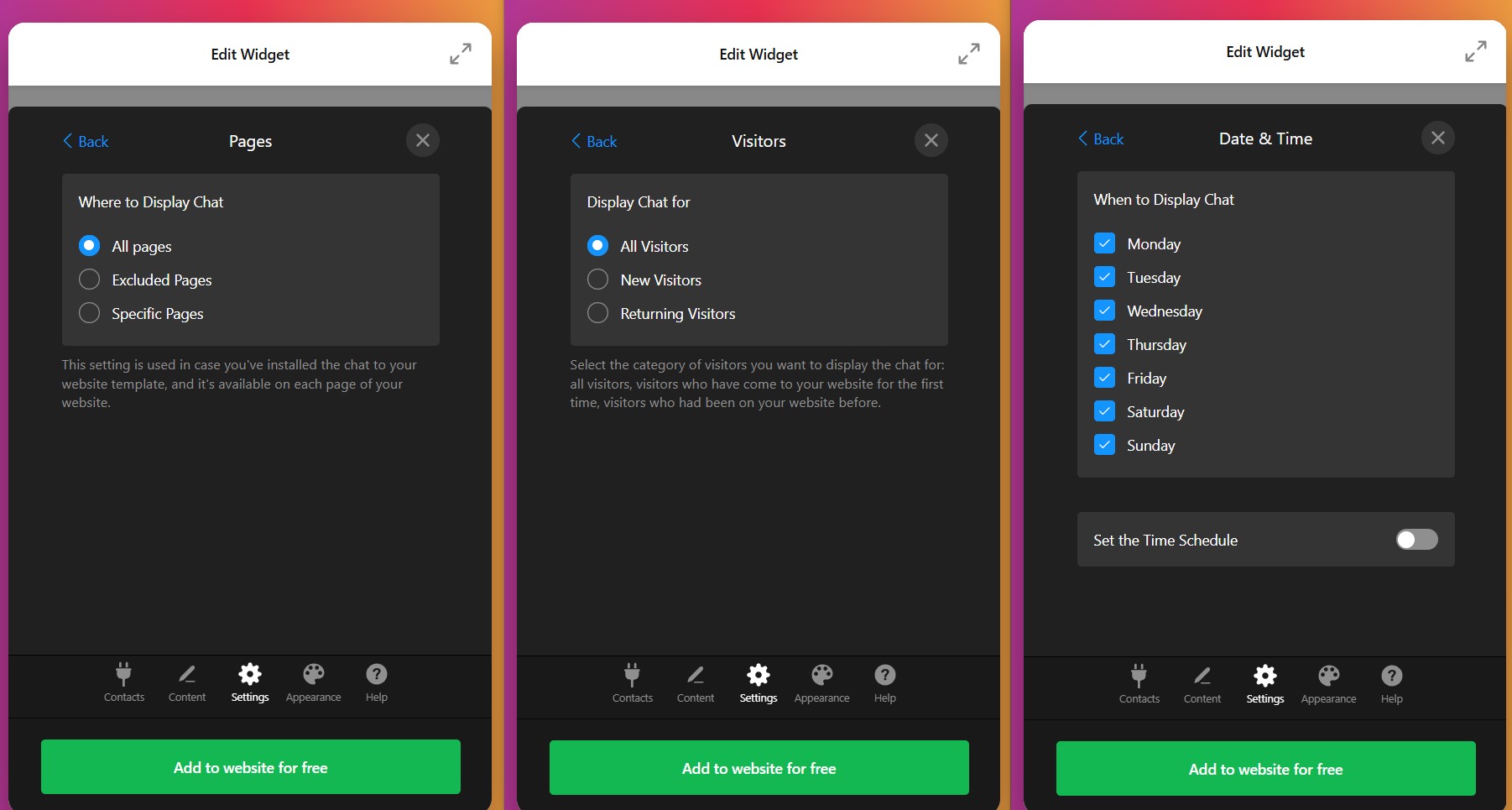
Under Open Chat Triggers, configure which visitor actions automatically open the chat window:
- On Page Load (immediately when page loads—use sparingly as it can feel intrusive)
- Time on Page (after visitor spends X seconds on current page)
- Time on Site (after visitor spends X seconds anywhere on your website)
- Scroll Position (when visitor scrolls to X% of page)
- Exit Intent (when visitor attempts to leave the page or close browser tab)
6. Choose Your Layout and Positioning
In the ‘Settings’ tab under Position, select between Floating (chat bubble follows users as they scroll, remaining visible at all times) or Embed (static placement within page content).
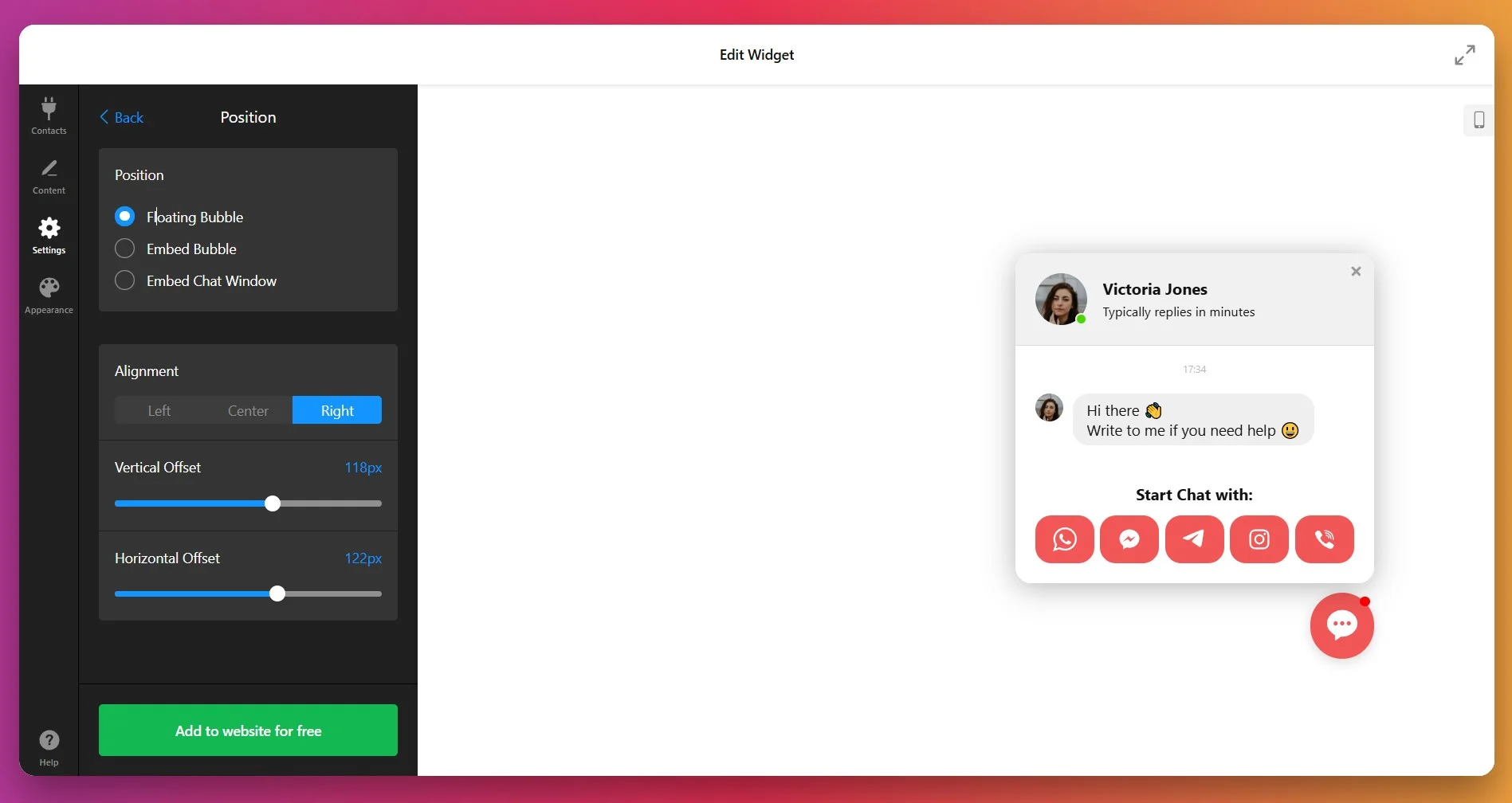
For floating layouts, choose corner position—bottom-right is the web convention and performs best in Western markets, while bottom-left can work for right-to-left languages or to avoid conflicts with existing website elements. Adjust horizontal offset and vertical offset to fine-tune exact positioning relative to screen edges.
7. Customize Appearance and Branding
Open the “Appearance” tab to match the widget to your website’s visual identity. Customize these elements:
- Chat Bubble: Adjust background color, shadow effects, and size. Enable or disable the notification badge and customize its color and text.
- Widget Header: Modify header background color, text color, and layout style. This is the top section visitors see when chat opens, featuring your agent info.
- Widget Background: Set the background color or image for the main chat panel. Light themes work best for professional services; darker themes suit tech and gaming brands.
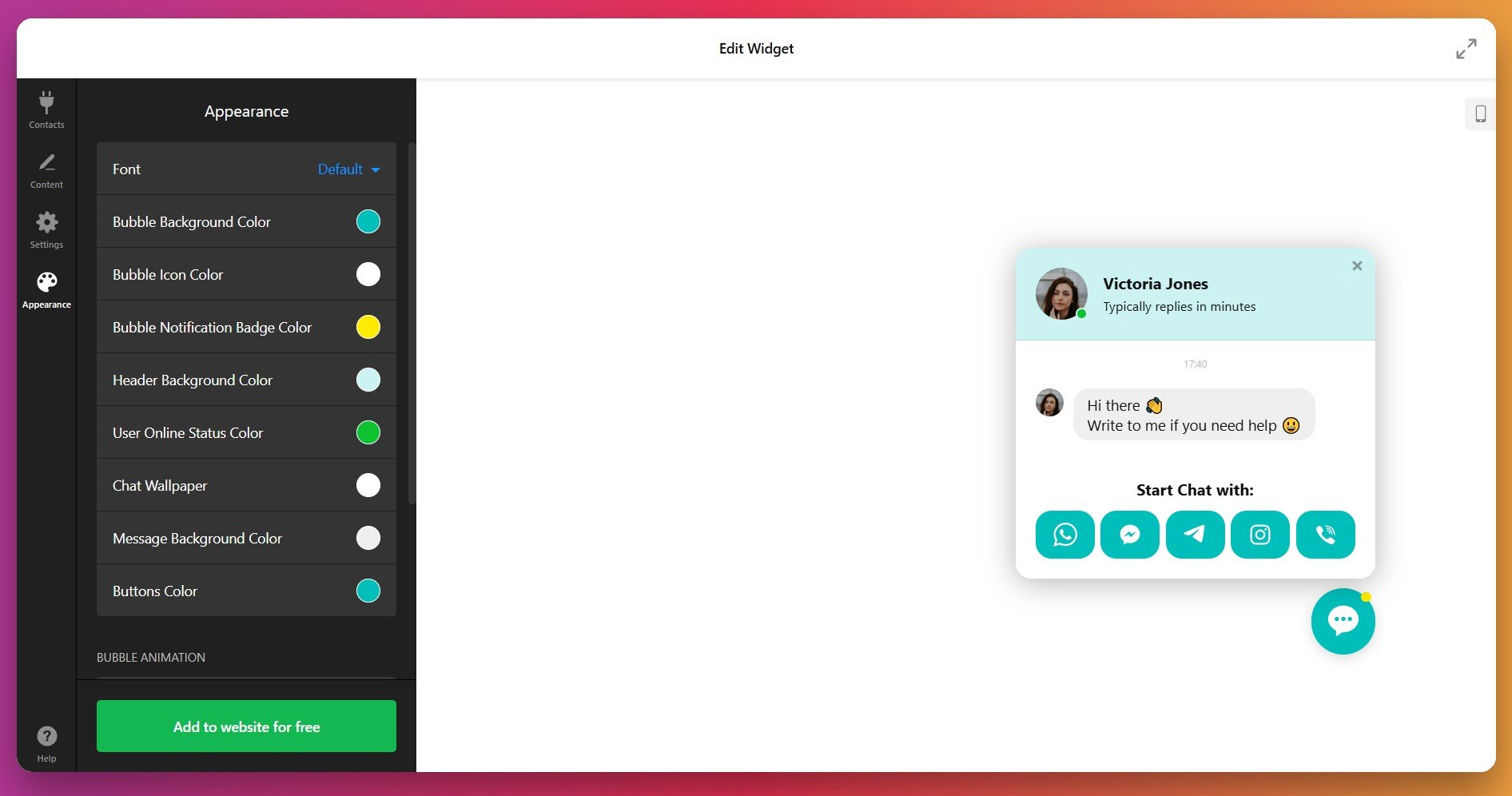
- Messenger Buttons: Customize individual channel button colors and styles. You can maintain platform brand colors (WhatsApp green, Messenger blue) or unify them with your brand palette.
- Typography: Select font families that match your website. Consistent typography strengthens brand cohesion and improves readability.
- Animations: Choose entrance and exit animation styles—subtle fades feel professional, while bounces and slides add energy for youth-oriented brands.
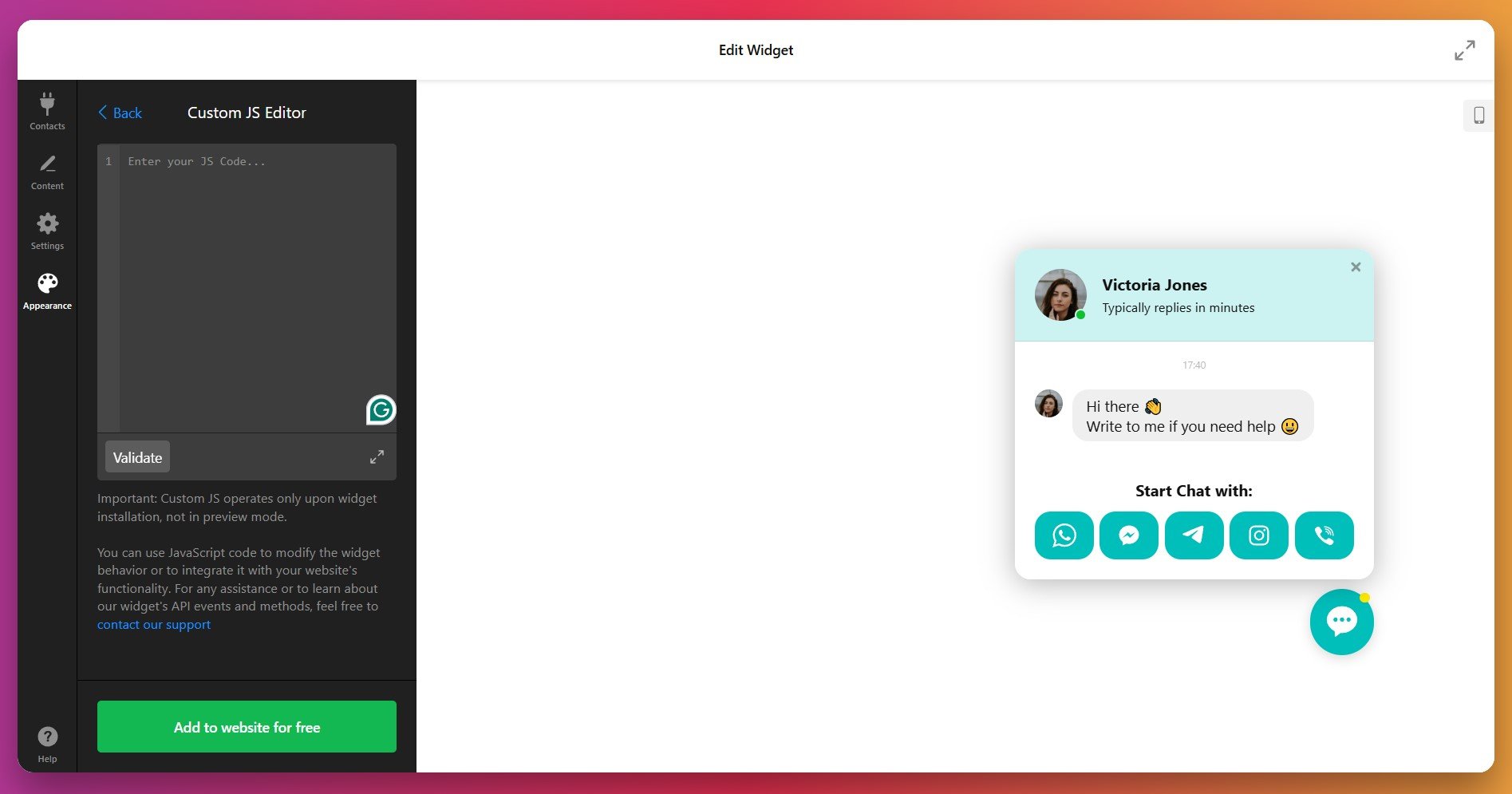
For advanced customization, use the Custom CSS field to apply precise styling rules, and Custom JavaScript to trigger custom events or integrate with other website functionality.
8. Enable Tracking
Return to the “Settings” tab and scroll to Google Analytics. Toggle on event tracking to monitor chat interactions—the widget will send events when visitors open chat, click messaging channels, or close the widget.
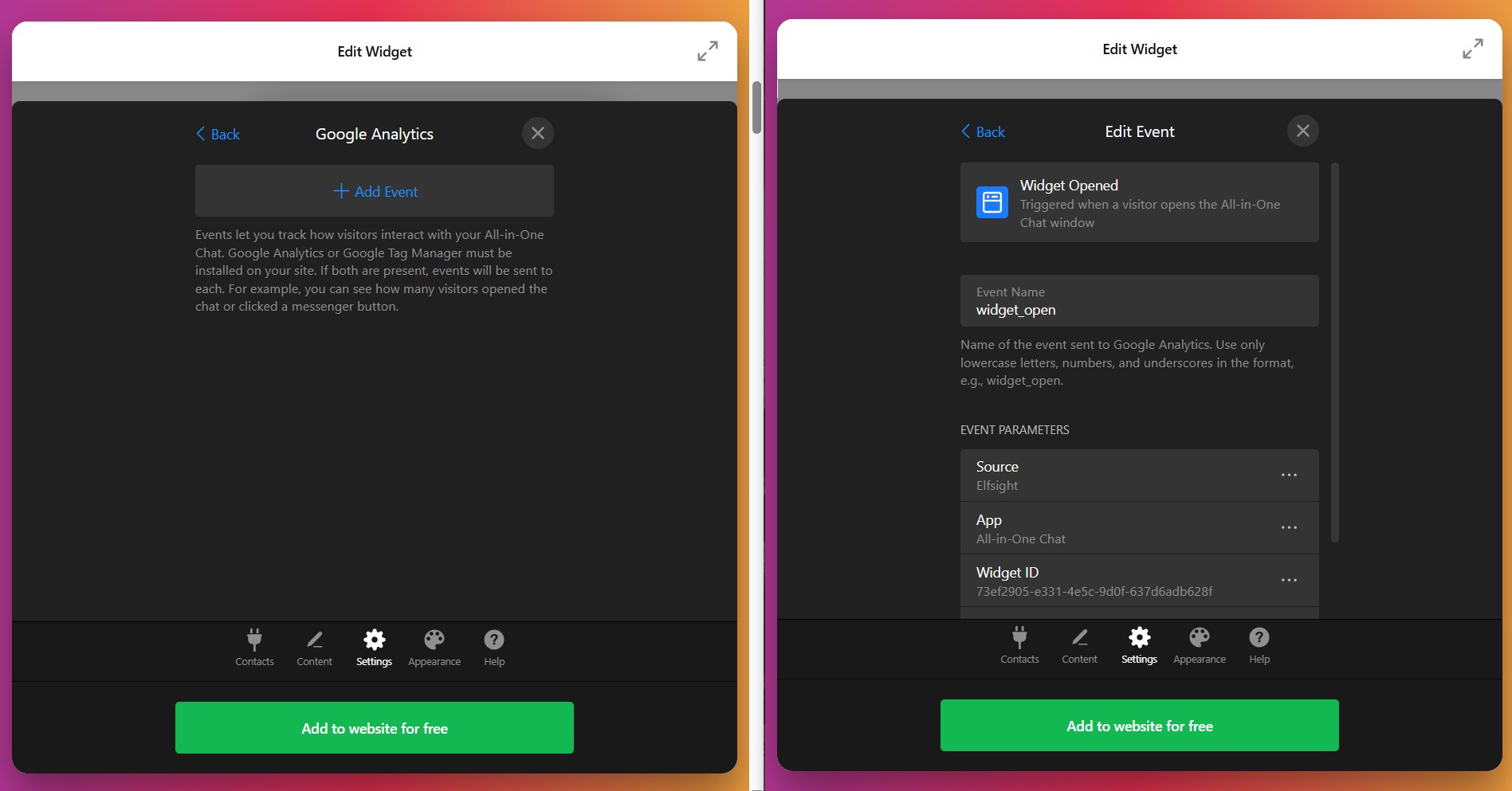
These events appear in your Google Analytics dashboard, allowing you to measure chat engagement rates, identify which channels perform best, and calculate chat-to-conversion metrics. If you use Google Tag Manager instead of direct Analytics implementation, the events will flow through your existing GTM setup automatically.
9. Embed Chat Widget on Your Website
Click “Add to website for free” to generate your unique installation code:

After installation, test thoroughly: verify chat appears on intended pages, test all messaging channel links to confirm they open correctly, check mobile responsiveness across devices, and ensure chat doesn’t overlap critical page elements or navigation.
📝 Live Chat Optimization Tips
Live chat can be a game-changer for customer engagement and conversions, but only if you set it up thoughtfully. Here are practical, no-nonsense tips to help you get the most out of your widget—clearer conversations, happier visitors, and better results.
- Keep the widget lightweight and fast Choose a solution that minimizes the size of the chat code and loads only what’s needed, when it’s needed. A smaller, optimized widget means your website stays speedy and your visitors don’t bounce before the chat even loads.
- Be smart about when the chat appears Avoid aggressive pop-ups the moment someone lands on your website. Instead, use behavior-based triggers—like idling on a key page or returning to the pricing section—to invite conversation when visitors actually seem interested or stuck.
- Personalize the greeting and appearance Match the widget’s colors and messages to your brand, and tailor greetings for high-intent pages. A friendly, relevant welcome makes chat feel helpful, not intrusive.
- Set clear expectations for availability If your team isn’t online 24/7, say so. Let visitors know when they can expect a reply, and consider an offline form for after-hours questions.
- Route chats to the right people Don’t dump every question on a single agent. Use smart routing to connect visitors with the team member best equipped to help, improving both speed and satisfaction.
- Make it easy to start and continue the conversation Offer pre-chat forms to collect basic info, but keep them short. Save chat transcripts so returning visitors (and your team) can pick up where they left off.
- Train your team and track what works Equip your agents with clear guidelines and a knowledge base. Monitor missed chats, response times, and customer feedback to spot trends and make ongoing improvements.
- Test, measure, and refine Experiment with different triggers, messages, and widget placements. Use analytics to see what drives engagement and conversions, then adjust your approach based on real data.
Live Chat Issues & Fixes
Wondering about setup or want to fine-tune your live chat experience? Here’s a round-up of the most asked questions and expert answers.
How do I add the live chat widget to my website?
Can I connect multiple messaging platforms to one chat widget?
How do I customize the chat’s design and position?
Is coding knowledge required for setup or customization?
How do I set up triggers for when the chat widget appears?
Can I create agent profiles and welcome messages?
How do I manage widgets for multiple websites or clients?
What if I run into issues during setup or installation?
Need More Help?
You now have a strong starting point for customizing live chat on your website. If you run into questions or want to share how you’ve set up your chat, we’d love to hear from you. Stay in touch with the Elfsight team on X, Facebook, and LinkedIn for updates, tips, and conversation.


